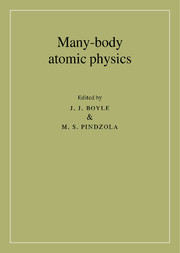Book contents
- Front Matter
- Contents
- Foreword
- Contributors
- Preface
- Acknowledgements
- Part 1 ATOMIC STRUCTURE
- Part 2 PHOTOIONIZATION OF ATOMS
- 4 Many-body effects in single photoionization processes
- 5 Photoionization dominated by double excitation in two-electron and divalent atoms
- 6 Direct double photoionization in atoms
- 7 Photoelectron angular distributions
- Part 3 ATOMIC SCATTERING: A. General Considerations
- Part 3 ATOMIC SCATTERING: B. Low-order applications
- Part 3 ATOMIC SCATTERING: C. All-order applications
- Appendix: Units and notation
- References
- Index
5 - Photoionization dominated by double excitation in two-electron and divalent atoms
Published online by Cambridge University Press: 22 September 2009
- Front Matter
- Contents
- Foreword
- Contributors
- Preface
- Acknowledgements
- Part 1 ATOMIC STRUCTURE
- Part 2 PHOTOIONIZATION OF ATOMS
- 4 Many-body effects in single photoionization processes
- 5 Photoionization dominated by double excitation in two-electron and divalent atoms
- 6 Direct double photoionization in atoms
- 7 Photoelectron angular distributions
- Part 3 ATOMIC SCATTERING: A. General Considerations
- Part 3 ATOMIC SCATTERING: B. Low-order applications
- Part 3 ATOMIC SCATTERING: C. All-order applications
- Appendix: Units and notation
- References
- Index
Summary
Introduction
Photoionization of a two-electron or a divalent atom in the vicinity of a doubly excited resonance due to the strong interaction between two outer electrons represents perhaps one of the most direct and unambiguous atomic processes for a quantitative study of the many-electron effects in atomic transitions. Recent applications of high resolution intense lasers and elaborate experiments in shorter wavelength regions with more advanced applications of synchrotron radiation to highly correlated atomic systems have opened up more opportunities for such a study. For example, operating at high synchrotron radiation intensity, Domke, Remmers, and Kaindl have recently observed the doubly-excited 2pnd1P series of He below the He+N = 2 threshold with an improved energy resolution of ≅ 4 meV. Parallel to the fast growing experimental advances, significant progress have also been made in many of the existing theoretical approaches.
One of the best known doubly excited photoionization structures is perhaps the He 2s2p1P resonance shown in Fig. 5.1. This resonance was first observed in detail by Madden and Codling in He photoionization from its ground state and classified subsequently by Cooper, Fano, and Prats. Theoretically, the photoionization structure of an isolated resonance located at resonant energy Er is best described by the Fano formula in terms of a set of resonant parameters, which includes the resonance width Γ, the asymmetry parameter q, and the nonresonant background cross section σb.
- Type
- Chapter
- Information
- Many-Body Atomic Physics , pp. 125 - 149Publisher: Cambridge University PressPrint publication year: 1998
- 13
- Cited by



